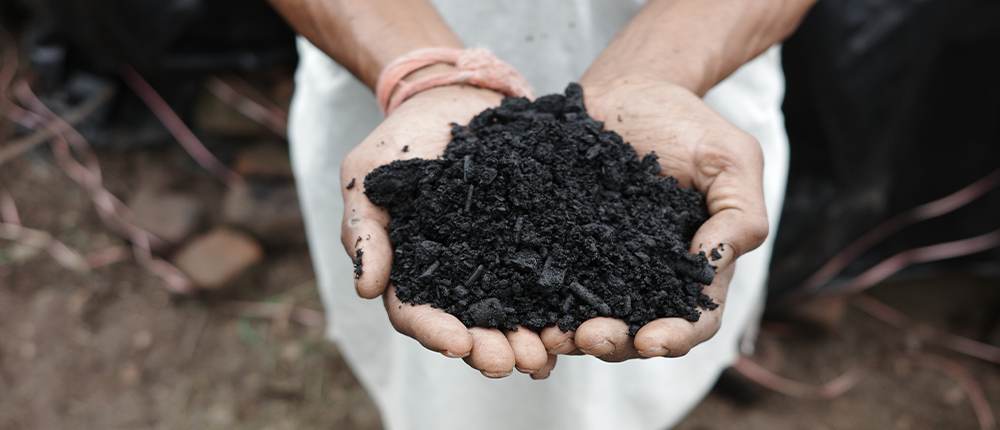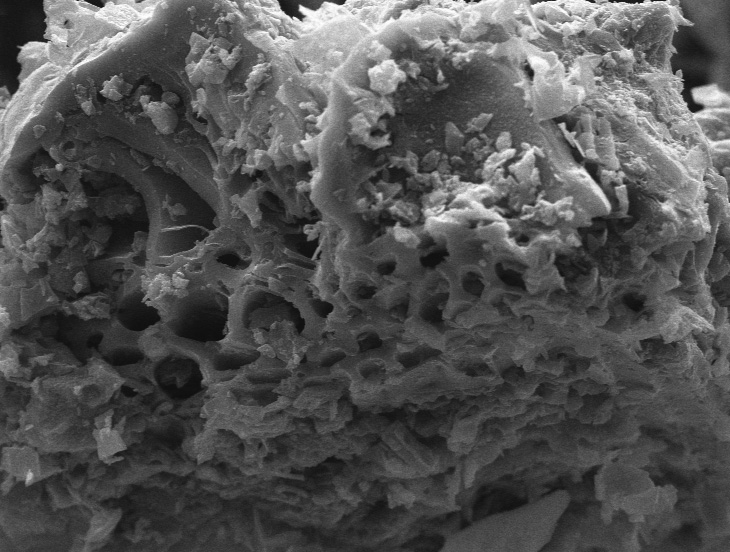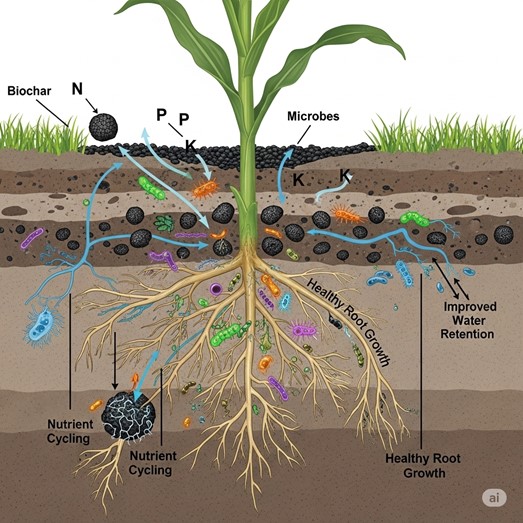Combining biochar with soil microbial communities can enhance soil health, nutrient cycling, and agricultural productivity. Being a stable carbonaceous material, biochar offers multiple benefits by improving soil’s physical, chemical, and biological properties.

The Intergovernmental Panel on Climate Change (IPCC) defines Carbon Dioxide Removal (CDR) as human activities capturing carbon dioxide (CO2) from the atmosphere and storing it durably in geological, land, ocean reservoirs or in products. This includes human enhancement of natural removal processes but excludes natural uptake not caused directly by human activities. CDR is primarily of two types: nature-based (conventional) or technology-based (novel).
As of 2024, CDR capacity remains far below what is needed to keep global warming under 2ºC. Current CDR accounts for about 2 GtCO2 per year, compared to the 12–16 GtCO2 per year required to align with the Paris Agreement goals. Within this, novel CDR approaches remain at a nascent stage, contributing just 0.002 GtCO2 per year.
Biochar: A CDR Strategy
There are several methods of CDR, but these can be broadly categorized into two main types or routes through the carbon cycle: biological and geological. Among the biological approaches, biochar stands out. It is a relatively stable, carbon-rich material produced by heating biomass in an oxygen-limited environment (pyrolysis). By storing carbon in vegetation, soils, and sediments, biochar represents a novel CDR technique. Emerging research, market sentiment, and rising investments suggest that biochar is not only effective but also one of the scalable, rapidly available, and affordable CDR strategies today.
Extensive research, including a systematic review (Schmidt, H.-P., Kammann, C. et.al 2021) of over 1,500 scientific papers, highlights the positive impacts of biochar in agriculture. Biochar application positively impacts plant productivity by 16%, crop yield by 13%, water use efficiency by 20%, soil organic carbon by 39%, and available soil nutrients by 45% for phosphorus. Furthermore, it reduces emissions of nitrogen oxides by 11% and plant heavy metal uptake by 29%.
Biochar Use and Benefits
Combining biochar with soil microbial communities can enhance soil health, nutrient cycling, and agricultural productivity. Being a stable carbonaceous material, biochar offers multiple benefits by improving soil’s physical, chemical, and biological properties. It also provides a unique habitat and nutrient source for beneficial microorganisms, promoting microbial diversity, abundance, and functional activity, which further augments nutrient availability, soil structure, and plant resilience. The combined application of biochar and microbes offers a powerful tool for sustainable agriculture and environmental remediation. It also enhances soil properties through carbon enrichment. However, optimizing their collective use requires careful consideration of biochar characteristics, soil properties, and the input microbes.
The benefits of biochar application are multifaceted, particularly in enhancing soil health. Its sponge-like structure (Figure 1) significantly improves soil water-holding capacity, with studies reporting increases of up to 22% in drought-prone and sandy soils (Khan, et al 2024). At the same time, enhanced water infiltration helps reduce both evaporation and surface runoff, making soils more resilient to water stress.
In terms of nutrient management, biochar plays a crucial role by increasing the soil’s cation exchange capacity (CEC) by 4–30% (Xu, et al., 2024). Elevated CEC allows the soil to effectively absorb and release more nutrients, including nitrogen (N), phosphorus (P), potassium (K), calcium (Ca), and magnesium (Mg), thereby significantly improving nutrient availability to plant roots while reducing nutrient leaching (Sun, et al. 2022). Moreover, as a stable carbon sink, biochar’s porous structure provides an effective hub for microbial interactions, contributing to long-term carbon sequestration and helping to mitigate climate change impacts.

Figure 1: Ultrastructure of Biochar showing its porous nature and sites for interaction with microbes
Furthermore, biochar has a profound impact (Figure 2) on soil structure and physical properties. It reduces soil bulk density, alleviates compaction in clayey soils, raises pH in acidic soils, and enhances aggregate stability and porosity. These improvements translate into better soil aeration, nutrient accessibility, and deeper root penetration. Additionally, the pores within biochar provide a secure habitat for microbes, fostering the recruitment of synergistic soil microbes such as mycorrhizal fungi and plant growth-promoting bacteria. This synergy helps build a more conducive environment for plant growth (Subedi, et al 2017; Anbuganesan, et al 2024).

Figure 2:Impact of biochar and microbe supplementation in soil (This is an AI generated image)
The combined use of biochar and microbes has been shown to boost crop yields. For instance, in cabbage cultivation, soils supplemented with both biochar and microbes achieved yield increase of 8.8% and 5% compared to the application of microbes or biochar alone (Luan, et al 2023). This combined application also significantly improved the phosphorus content of Chinese cabbage by 36.3%.
Other studies confirm that biochar-based microbial inoculants enhance root and shoot biomass, promote nodulation, and improve nutrient uptake in various plants, leading to enhanced growth and grain yield in both controlled pot experiments and large-scale field trials (Egamberdieva, et al 2018). Such improvements are closely linked to enhanced soil fertility, higher soil organic matter, greater availability of nutrients such as phosphorus and potassium, and elevated soil enzyme activities (e.g., phosphatase and urease).
This integrated biochar-microbe approach represents a ‘climate-smart farming practice’: it not only supports plant productivity growth but also strengthens the soil’s capacity to act as a carbon sink, thereby augmenting agricultural sustainability without the negative environmental consequences often associated with indiscriminate use of traditional chemical fertilizers.
The Way Forward
Biochar with its stable carbon structure and unique surface chemistry, being highly recalcitrant, resists decomposition and contributes significantly to long-term carbon sequestration in soils while immobilizing various heavy metals and organic pollutants, thereby reducing environmental risks (Rizwan, et al 2023). The consistent evidence across various studies, detailing biochar’s influence on physical, chemical, and biological soil properties, suggests that it acts as a multi-functional soil engineering material. Nevertheless, application of biochar with microbial incorporation through formulation, direct mixing, encapsulation, and pelletization can enhance its impact on nutrient availability and utilization (Divyangkumar and Panwar 2024; Xu, et al 2024).
Biochar, when combined with microbes, is not merely a soil amendment–it has the potential to fundamentally re-engineer the soil matrix. This comprehensive transformation makes biochar-microbe applications a strategic, long-term investment in soil health, laying a robust foundation for sustained microbial activity, enhanced carbon storage, and overall ecosystem resilience.
In addition to directly storing carbon, biochar also enhances the soil’s ability to capture and convert atmospheric CO2 into stable mineral forms, thereby boosting sequestration potential. Importantly, the carbon retained in biochar is highly resistant to decomposition, offering over 100 years of carbon permanence (Gui, et al., 2025).
To fully realize this potential, it is essential to scale up and diversify biochar applications in agriculture, agroforestry, and forestry systems. Addressing current challenges–such as variability in outcomes across soil types and management practices–will be critical for developing carbon- and biologically rich soils, and for leveraging this synergy to build climate-resilient agroecosystems.
References
- Gui, X., Xu, X., Zhang, Z. et al. (2025). Biochar-amended soil can further sorb atmospheric CO2 for more carbon sequestration. Commun Earth Environ 6, 5. https://doi.org/10.1038/s43247-024-01985-5
- Khan S., Irshad S., Mehmood K., Hasnain Z., Nawaz M., Rais A., Gul S., Wahid M.A., Hashem A., Abd Allah E.F., and Ibrar D. (2024). Biochar Production and Characteristics, Its Impacts on Soil Health, Crop Production, and Yield Enhancement: A Review. Plants (Basel);13(2):166. doi: 10.3390/plants13020166
- Luan J., Fu Y., Tang W., Yang F., Li X., Yu Z. (2023). Impact of Interaction between Biochar and Soil Microorganisms on Growth of Chinese Cabbage by Increasing Soil Fertility. Applied Sciences.; 13(23):12545
- Rizwan M., Murtaza G., Zulfiqar F., Moosa A., Iqbal R., Ahmed Z., Irshad S., Khan I., Li T., Chen J., Zhang M., Siddique K.H.M., Leng L., and Li H. (2023). Sustainable manufacture and application of biochar to improve soil properties and remediate soil contaminated with organic impurities: a systematic review. Environ. Sci.11:1277240
- Schmidt, H.-P., Kammann, C., Hagemann, N., Leifeld, J., Bucheli, T. D., Sánchez Monedero, M. A., & Cayuela, M. L. (2021). Biochar in agriculture – A systematic review of 26 global meta-analyses. GCB Bioenergy, 13, 1708–1730. https://doi.org/10.1111/gcbb.12889
- Subedi, R. et al. (2017). Italian Journal of Agronomy12; 161-173 “Crop response to soils amended with biochar: expected benefits and unintended risks
- Sun Z., Hu Y., Shi L., Li G., Pang Z., Liu S., et al. (2022). Effects of biochar on soil chemical properties: A global meta-analysis of agricultural soil. Plant Soil Environ; 68(6):272-289. doi: 10.17221/522/2021-PSE
- Xu, L., Wu, K. C., Deng, Z. N., Huang, C. M., Verma, K. K., Pang, T., & Huang, H. R. (2024). Biochar and its impact on soil profile and plant development. Journal of Plant Interactions, 19(1). https://doi.org/10.1080/17429145.2024.2401356
